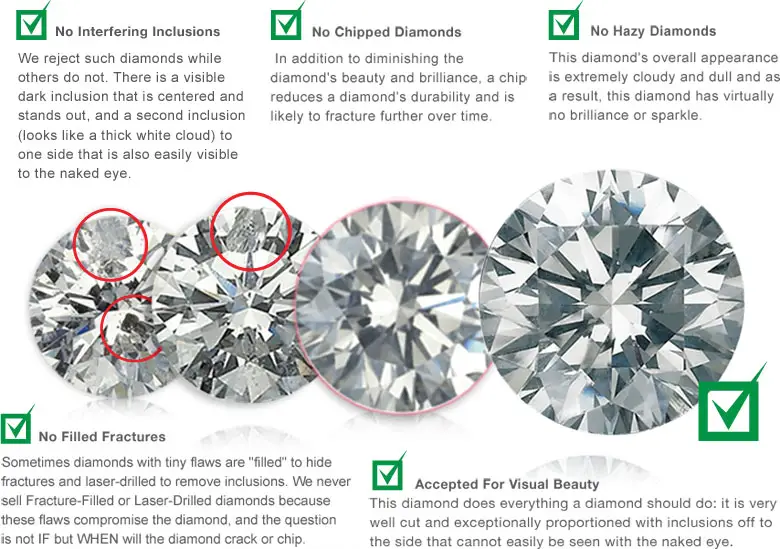Determining Diamond Quality
When searching for the perfect diamond, you will quickly learn that price differences vary greatly. The price of a diamond is commonly determined by using the four “C’s” for judging a diamond’s quality, where the four C’s include: color, clarity, carat and cut. It is a good idea to learn what each of these terms mean and choose a reliable jeweler before buying diamonds. Of course you can inspect diamonds personally, but the only way to guarantee a good value for the money is to use the knowledge of a diamond professional.
Using a Jeweler’s Loupe to Judge Diamond Quality
Jewelers commonly use a type of magnifying glass, called a loupe, to judge a diamond’s quality and to examine it for inclusions and flaws. Keep in mind that you should expect at least a few imperfections, because perfect diamonds that are flawless are not only rare, but they are also very costly. Inclusions can include cleavage, pinpoint, growth lines, laser lines, bearding, feathers and grain lines. Any reputable and honest jeweler will allow you to examine your engagement ring using their loupe.
Diamond Quality: Color
When determining the rating for a diamond’s color, jewelers usually use letters D to Z. The more brown or yellow tint that a diamond has, the less the value will be. In other words, a colorless diamond would be rated D, while a diamond that has a light brown or yellow hue will be rated Z.
Diamond Quality: Clarity
Is the diamond you are viewing clear or cloudy? A diamond’s clarity denotes the stone’s clearness. If a gem has many inclusions, it won’t be as valuable as a diamond with very few flaws. Clarity is rated by jewelers using the chart that follows:
• I1, I2, I3 – Diamonds that have flaws you can see with your naked eyes.
• SI1, SI2, SI3 – These numbers represent diamonds that have small flaws.
• VS1, VS2 – These are diamonds with very small flaws.
• VVS1, VVS2 – These are diamonds that contain very, very small flaws.
• Internally Flawless – Diamonds with this rating have blemishes that are very minor and on the stone’s outer portion.
• Flawless – These are obviously diamonds that don’t have inclusions and are thought of as perfect.
Diamond Quality: Carat
Carat is the word used to refer to a diamond’s size. Each carat is equal to a hundred points. The weight of the carat is used to describe the mass of the diamond. Diamonds that are larger will obviously be more expensive, but other factors such as clarity, cut and color will also need to considered to properly value diamonds.
Diamond Quality: Cut
Can you remember seeing a beautiful diamond that catches light and sends sparkles around the room? Well, more than likely that diamond had a great cut! A diamond’s cut refers to the amount of perfectly-proportioned facets inside the stone. A good cut allows the diamond to sparkle. The cut also refers to the shape of the diamond. For instance, emerald, oval, round or pear.
Diamond Quality: Treated Diamonds
One vital question that you must ask the jeweler is if the diamond you like has been treated. These types of diamonds have either had glass fillers inserted or have been painted to make them look clearer. It’s a good idea to ask for a certificate that proves the diamond is not treated.
In the end, there are many considerations when it comes to determining the quality of a diamond. However, the best ways to judge a stone’s value is whether the bride-to-be likes it or not, if it fits into the couple’s budget or if it symbolizes their relationship or not.
The bottom line? It’s all here:







